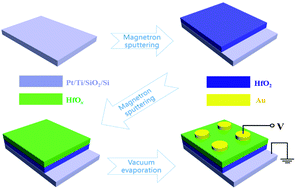Resistive switching of the HfOx/HfO2 bilayer heterostructure and its transmission characteristics as a synapse
Abstract
In this work, HfOx/HfO2 homo-bilayer structure based resistive random access memory devices were fabricated, and the resistive switching characteristics of the devices were investigated. The samples with an Ar/O2 ratio of 12 : 2 exhibited improved switching performance including better uniformity, endurance and retention, which was selected to imitate the “learning” and “forgetting” function of biological synapses. The multilevel conductance of the HfOx/HfO2 homo-bilayer structure under the model of pulse voltage suggests its potential to emulate the nonlinear transmission characteristics of the synapse, and a model of multilevel conductance of the HfOx/HfO2 homo-bilayer structure was proposed. The device conductance continuously increases (decreases) in accordance with the number of positive (negative) voltage pulses during the potentiation (depression) process, which can emulate the change of synaptic weight in a biological synapse.



 Please wait while we load your content...
Please wait while we load your content...